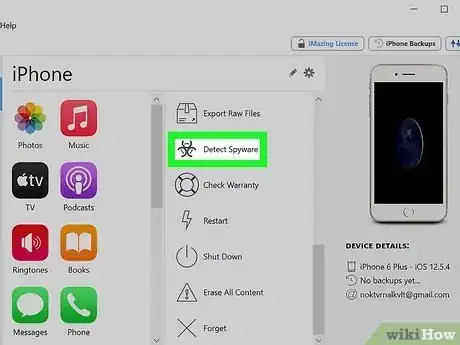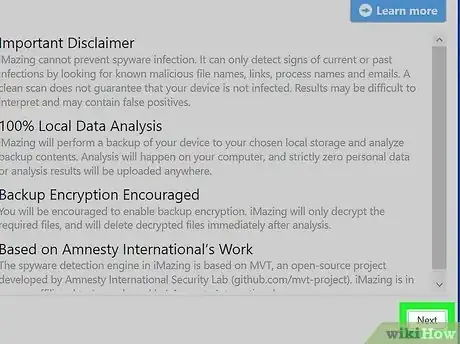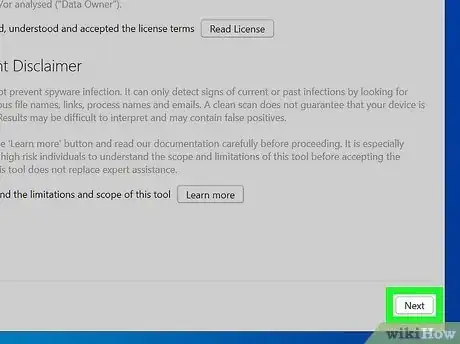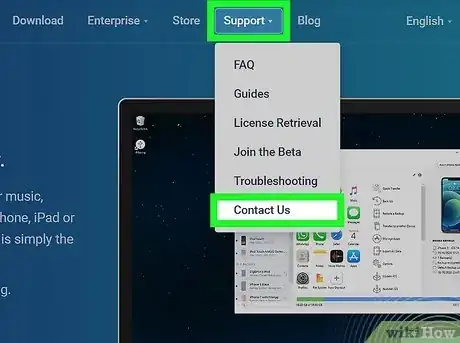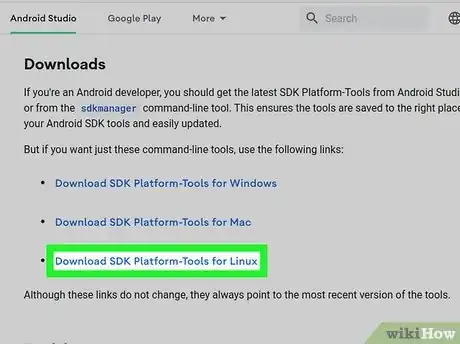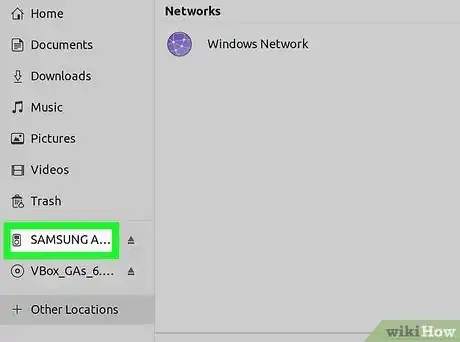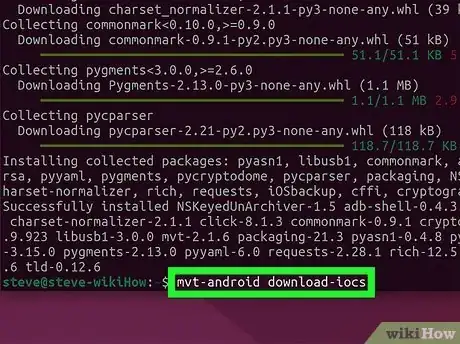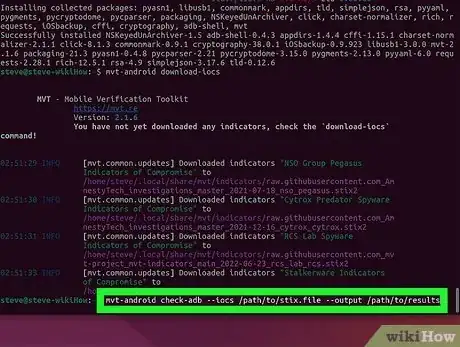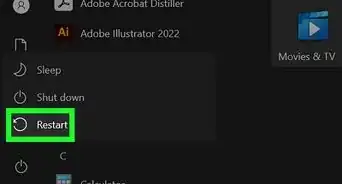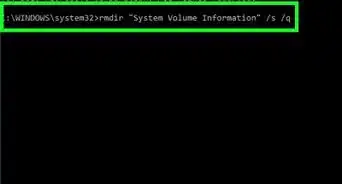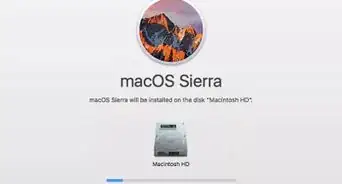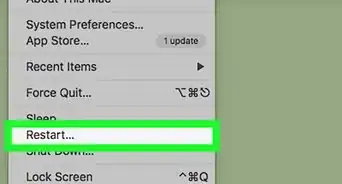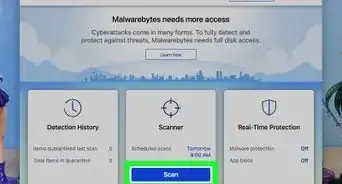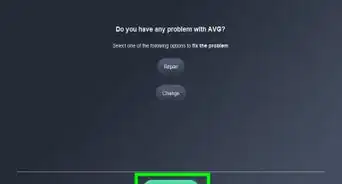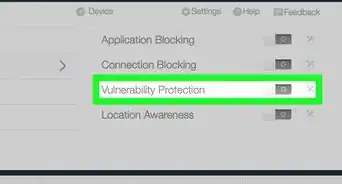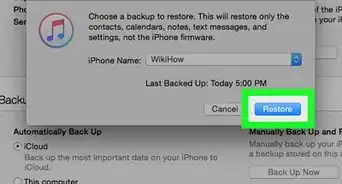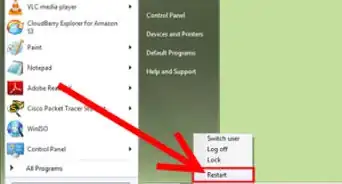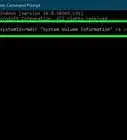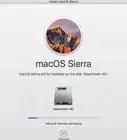This article was co-authored by wikiHow staff writer, Cory Stillman. Cory Stillman is a Technology Writer for wikiHow. Cory has experience writing about Film and TV for several online publications, including Screen Rant and Film Cred. He earned a degree in Film and Media Studies with a minor in Creative Writing and certificates in Global Studies and Children’s Literature from the University of Pittsburgh.
There are 7 references cited in this article, which can be found at the bottom of the page.
This article has been viewed 37,167 times.
Learn more...
Pegasus Spyware is malicious spyware that steals sensitive information from innocent mobile device owners. Experts estimate that roughly 50 thousand devices have been infected with Pegasus since 2021.[1] Unfortunately, traditional antivirus software cannot detect Pegasus. If you are worried that you have Pegasus on your Android, iPhone, or iPad, you can use MVT, a free tool designed by Amnesty International's Security Lab, to scan your phone or tablet. This wikiHow article will teach you how to use the tool and find out if you have Pegasus spyware on your mobile device.
Things You Should Know
- MVT is a command-line program designed for Linux, but you can also use it on macOS.
- If you want to scan an iPhone or iPad, you can use a graphical program on your PC or Mac called iMazing, which works like MVT.
- Running MVT requires at least some technical familiarity with the Linux command line. If you find the process overwhelming, consider bringing your device to an expert.
Steps
Detecting on iPhone and iPad (Windows & Mac)
-
1Visit https://imazing.com/guides/detect-pegasus-and-other-spyware-on-iphone on your Mac or PC. Software developers iMazing have set up an easy way for iPhone owners to scan for Pegasus spyware.
- iMazing's tool emulates the original Mobile Verification Kit from Amnesty International. Amnesty's tool requires prior configuration on a MacOS or Linux device, however, so iPhone users are advised to use iMazing's simpler alternative.
-
2Download iMazing. Click the Free Download button to download iMazing onto your computer. The free application allows you to manage your iPhone from your Mac or PC. Most importantly, it contains the spyware detection tool we need to search for Pegasus.
- iMazing offers a paid version, but its free trial includes the spyware detection tool without time limit or restriction.
Advertisement -
3Connect your iPhone or iPad to your computer. Use the USB cable that came with your phone or tablet or a compatible replacement.
- If you have previously backed up your device to iMazing, you can scan that backup without connecting a device.
-
4Launch iMazing. The application should detect your phone immediately. You will have to enter your phone's passcode to complete the pairing process.
- Make sure your phone is unlocked while pairing it with iMazing.
- Make sure you have an internet connection on both devices.
-
5Click Detect Spyware in the Actions panel. On the right-hand side of the iMazing client is a list of all the actions you may take. Scroll down until you find Detect Spyware and click it. It is represented by a "toxic" icon.
- If you have multiple Apple devices synced with iMazing, make sure you have the appropriate one selected in the left sidebar.
-
6Follow the on-screen instructions to select your preferences. iMazing will provide you with some information. Click Next to proceed to configuration, where you can accept the default settings and click Next again.
- The configuration page allows you to choose between a .csv and .xlsx file for your exported report. The default .csv should be fine, as you can always convert it to an .xlsx later.
- You will also be asked about creating a backup of your device. You may skip this step, or create a backup if you so choose.
-
7Click Start Analysis to start the scan. If you chose to create a backup, iMazing will carry that process out first, which may take a while depending upon your device's storage.
-
8Interpret your results. Once the scan is done, a pop-up will report the scan's findings. A clean scan will include the phrase No signs of infection detected. If iMazing detects spyware, it will say Possible infection detected. [2]
- If you have a clean scan, you do not need to open your report. While false positives can happen, false negatives are not a concern.
-
9Open and read your report. iMazing's report will detail all critical detections. Pay particular attention to the Malware column and search for the term Pegasus.
- If you do not see any of the detected malware labeled as Pegasus, you do not have to worry about Pegasus spyware. Of course, you should still work to rid your device of any detected malware.
-
10Send your report to iMazing to check for false positives. Visit the website to share your report. The developer promises to get back to you quickly.
- If iMazing confirms your positive scan, they will connect you with the help needed to clean your device. Keep in mind their tool is purely a detection service.
- While waiting for a response from iMazing, you may continue to use your device, but you should refrain from communicating with others to not expose them to the malware.
Detecting on Android (Mac & Linux)
-
1Visit https://github.com/mvt-project/mvt on Linux or macOS. If you want to know if Pegasus is on your Android phone, you will have to use the official detection tool from Amnesty International. This tool is designed for forensics experts and only available for Linux and macOS. There's no graphical user interface, so you'll need to use the command line.
- You won't see any obvious "You have Pegasus!" notifications. However, you can use this tool to gather evidence that will be useful to share with experts.
- The Amnesty MVT can only offer limited insights on Android devices, as Androids do not store as much diagnostic information as iPhones.[3]
-
2If you're using a Mac, install Xcode and Homebrew. If you already have these tools installed you can skip this step.
- First, open your Mac's App Store, search for Xcode, and install it.
- Then, open a Terminal window
- Type this command and then press Return: /bin/bash -c "$(curl -fsSL https://raw.githubusercontent.com/Homebrew/install/HEAD/install.sh)".[4]
- Type export PATH="/usr/local/opt/python/libexec/bin:$PATH" and press Return.
-
3Download Python. You will need Python 3.6 or later installed on your computer to run MVT.
- Linux: Check your Python version by running python at the prompt. If it's an older version, use sudo apt-get install python (Ubuntu) or sudo yum install python (Redhat/Fedora) to update.
- Mac: The version of Python that comes with macOS is dated, so run the command brew install python to get the latest version.
-
4Install the dependencies. We need to install some basic dependencies that will allow us to run MVT.
- Linux: Run sudo apt install python3 python3-pip libusb-1.0-0 sqlite3.
- macOS: Run brew install python3 libusb sqlite3.
-
5Install Android SDK Platform Tools for Linux. This contains the tools you'll need to interact with your Android, including adb (Android Debug Bridge). You can download it from https://developer.android.com/studio/releases/platform-tools on Linux, or run brew install --cask android-platform-tools to install it on a Mac.[5]
-
6Install MVT. Here's how:
- Run export PATH=$PATH:~/.local/bin make sure your path is set to install Pypi binaries.
- Run pip3 install mvt to install using Python's package manager.
- If you'd rather compile from source code:
- First, run git clone https://github.com/mvt-project/mvt.git to download the source code.
- Then run cd mvt to enter the directory.
- Last, run pip3 install to compile and install.
-
7Enable debugging on your Android. If you haven't already done so, open your Android's Settings, tap About phone, then tap "Build Number" 7 times.[6] Tap the back button and you'll now see a menu called "Developer Options." Once enabled, you can turn on USB debugging:
- In your Settings, go to System > Advanced > Developer Options.
- Enable the "USB debugging" switch if disabled.
-
8Connect your Android to your PC with a USB cable. Ensure your device is unlocked and connected to the internet. When prompted on your Android, select Trust.
- MVT can only analyze SMS messages containing links, but these tend to be the most high-risk messages anyway.[7]
- MVT may request some extra permissions to scan parts of your device, but this would require you to jailbreak your device, which would only further expose your device to malware. Simply deny these permissions and accept the available scan.
-
9Run mvt-android download-iocs. With the MVT installed, Python can now interpret its commands. This command downloads files ending with the .stix2 file extension and saves them to the app directory.
- Run the ls -a command to find the files if you're not sure where they are. You'll need to specify the path to your .stix2 file to check for Pegasus.
-
10Run mvt-android check-adb --iocs /path/to/stix.file --output /path/to/results. This command will use all of MVT's options to check your Android over USB using the debug bridge, which can take a while.
- As data is compared to the specified .stix file, results will be recorded to the specified results folder. Possible matches will be indicated with a "WARNING" message, though the warnings may indicate spyware other than Pegasus.
- If you don’t want to scan your entire android, run mvt-android without any arguments to see which individual options are available. But if you're really concerned, just run through all of the checks with mvt-android.
References
- ↑ https://www.amnesty.org/en/latest/research/2021/07/forensic-methodology-report-how-to-catch-nso-groups-pegasus/
- ↑ https://imazing.com/guides/detect-pegasus-and-other-spyware-on-iphone
- ↑ https://docs.mvt.re/en/latest/android/methodology/
- ↑ https://brew.sh/
- ↑ https://docs.mvt.re/en/latest/install/
- ↑ https://developer.android.com/studio/debug/dev-options
- ↑ https://github.com/mvt-project/mvt/blob/main/docs/android/backup.md




